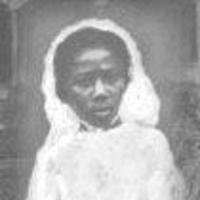
Thomas "Blind Tom" Wiggins was one of the most famous American entertainers of the 19th century. Blind from birth and born into slavery, Wiggins became well known for his piano virtuosity. Though undiagnosed at the time, it is likely that he was autistic as well. 



Thomas Greene Wiggins was born near Columbus on May 25, 1849, to Charity and Domingo Wiggins, slaves who were owned by Wiley Jones. After discovering that the infant was blind, Jones refused to feed or clothe him.
Wiggins's mother interceded to save his life, and several months later Wiggins, his two older siblings, and his parents were sold at auction to General James Bethune, a Columbus lawyer.
The Bethune family had seven musically gifted children who played piano or sang, and Wiggins stood by, rapt, as the children practiced. Soon, he began reproducing the music he heard on the keyboard.
Piano lessons were provided for him, and Wiggins's ability quickly surpassed that of his teachers. Bethune recognized his talent as a potential source of income, and Wiggins was hired out at the age of nine or ten to a traveling showman named Perry Oliver.
Wiggins's demanding tour schedule often included four performances a day, and as he grew into a large man, his graceful precision stunned audiences. 

From his earliest years "Blind Tom," as he became known, could mimic many kinds of sounds, from birdcalls to trains, with unbridled and uninhibited enthusiasm. In time he would incorporate such effects into his musical works, imitating wind and rain, for example...
... and claiming that the sounds of nature had taught him the melodies.
Wiggins's lack of emotional development coupled with extraordinary musical ability made him prime for exploitation.
Wiggins's lack of emotional development coupled with extraordinary musical ability made him prime for exploitation.
After the Civil War (1861-65) Bethune's son, John, took over the management of Blind Tom, and he used Wiggins's considerable income to support his own extravagant lifestyle.
Blind Tom's final years were spent holed up in Eliza Bethune's house in Hoboken, New Jersey, which had been purchased with Wiggins's earnings.
He died of a stroke on June 13, 1908, at the age of fifty-nine.
He died of a stroke on June 13, 1908, at the age of fifty-nine.

Source/read more: georgiaencyclopedia.org/articles/arts-… 

General Bethune's family eventually made a fortune estimated at $750,000 at the hands of Blind Tom.
• • •
Missing some Tweet in this thread? You can try to
force a refresh









